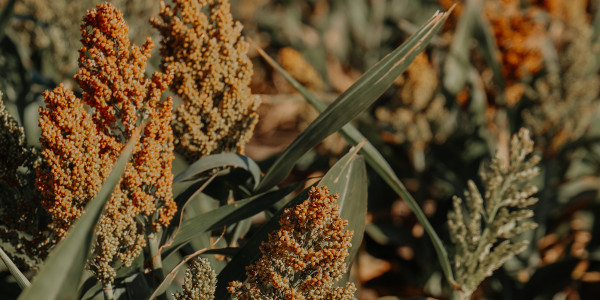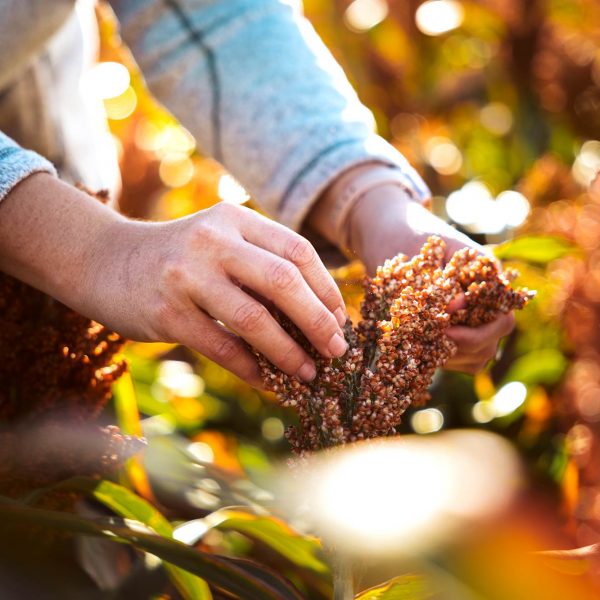
Uniform Heading and Off-Type Sorghum Plants
MAFG/HP August 2022
Brent Bean, Sorghum Checkoff Agronomist
One of the most attractive fields in agriculture is a weed-free, uniform stand of grain sorghum after heading. Sometimes fields will have heads with green grain mingled with heads that have turned color. Assuming uniform emergence, these green heads are later in maturity and originate from tillers. It is not unusual for grain in heads from tillers to be two weeks later in maturity than grain in the main stalk heads. How many and how late the tillers are is largely determined by seeding rate, early season environment and to some extent the genetics of the hybrid.
Off-type sorghum plants can also cause a lack of uniformity in a sorghum field. These off-type plants are often taller and may have different plant morphology than the planted grain sorghum hybrid. Assuming there is no seed from sorghum related species in the soil prior to planting, where do these off-types come from?
When parent lines are crossed to make hybrid sorghum seed, one of the parents is male sterile and called the A-line (female). The other parent line is fertile and is referred to as the R-line (male) and provides pollen for the A-line. In hybrid seed production several rows of A-line seed are planted alternating with a few R-line rows. When blooming of the lines occurs, the A-line rows are pollinated with pollen from the R-line plants and the seed produced from this cross is harvested and sold to growers for planting.
The system has proved very successful but, unfortunately, the male sterile A-line plants are susceptible to fertilization by foreign pollen from sorghum plants in, or in the vicinity of, the seed production field. Commercial seed production fields are isolated from other sorghum and wild species but, on occasion, foreign pollen can find its way to these male sterile plants. When this happens, the resulting seed looks identical to the desired hybrid seed and thus can end up in the bag of seed planted by the grower.
In addition to isolation, seed companies often use split planting dates of the fertile R-line parent to ensure a significant pollen load when the male sterile A-line plants are in bloom. Having multiple planting dates of the fertile R-line parent, it helps ensure synchronization of bloom between the two lines and limits the possibility that foreign pollen will pollinate male sterile R-line plants.
Off-type sorghums can be divided into five distinct groups:
- Tall mutants. These are the most common off-type plants. As the name implies, these plants are 1 foot to 3 feet taller than normal plants. Other than the height difference, they are identical to normal plants. Four genes are now known to affect height. The tall off-type is a result of one of the genes becoming unstable. Parent genotypes will vary in their frequency in producing tall off-types. With the use of genetic markers and other modern techniques, seed companies can greatly reduce the frequency of tall mutants. These technologies along with diligence from the seed companies the last few years have led to much fewer tall mutants showing up in commercial grain sorghum fields.
- Grain outcross or off-color panicles. These plants are usually similar in height to the desired hybrid but may have very different seed color or panicle shape. These off-type plants are a result of foreign pollen, which is usually from grain sorghum that contaminates the seed production field.
- Forage types or grain forage. This group exhibits characteristics associated with forage sorghum, meaning that the plants are normally tall and single stalked with a typical grain sorghum-type panicle. These plants originate from the pollen of forage sorghum typically used for silage.
- Open head forage, grassy sorghum or shatter-cane. This group results from pollen of sudangrass or sorghum-sudangrass hybrids in or near the seed production field. Plants can vary greatly in height and plant appearance and typically produce numerous tillers. The panicles are more grasslike, in that they are loose and open.
- Johnsongrass outcross. These plants occur when Johnsongrass pollinates the male sterile plants in the production field. This type of cross-pollination does not occur often due to the genetic incompatibility between Johnsongrass and grain sorghum. When it does occur, the resulting plants have rhizomes but seldom produce any viable seed. Plants are typically Johnsongrass-like in appearance with slender stalks, many tillers and an open panicle.




